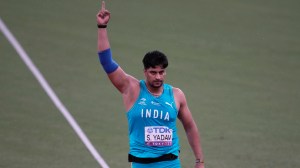Dust down the garland canal idea
Thirty years ago, the then union minister for irrigation, K.L. Rao mooted the idea of a Ganga-Cauvery link. Two years later, a more ambitiou...

Thirty years ago, the then union minister for irrigation, K.L. Rao mooted the idea of a Ganga-Cauvery link. Two years later, a more ambitious country-wide linking of waterways — the garland canal — was proposed by a pilot, Captain Dastur, who is said to have conceived the notion while flying over the maze of natural waterways across the country. The proposed garland canal would ensure that surplus water in any part of India could be utilised in water deficient regions. After 14 years of normal monsoons when all plans to counter the recurrent drought-flood situation took a backseat, the current scenario forces one to think of more permanent solution to the problem.
The garland canal first received official attention with the National Water Development Agency being set up in July 1982 to prepare feasibility studies. The project proposed a network of canals linking all the major rivers. The two main components of the project were the Himalayan Rivers Development Component and the Peninsular Rivers Development Component. The Himalayan Component included the construction of storage reservoirs on the principal tributaries of the Ganga and Brahmaputra in India, Nepal and Bhutan, along with inter-linking canal systems to transfer surplus flows from the east to the water-starved west. It also envisaged linking the Ganga with the Mahanadi. The project when complete would provide additional irrigation for about 22 million hectares and generate 30 million KW of power.
The Peninsular Rivers Component was more complex as the region contains several distinct water systems. The four major foci of the were, first, linking the east flowing rivers —the Mahanadi-Godavari-Krishna and Cauvery through a network of canals and reservoirs to distribute surpluses from the Mahanadi-Godavari basins to the drier south. Second, diverting the short west flowing rivers across the Western Ghats to prevent the waters from this heavy rainfall catchment area from rushing into the Arabian Sea and, in the process, meeting Kerala’s needs as well as the needs of drought-affected states in the rain shadow of the Western Ghats. Third, linking the Ken and Chambal to provide a water grid for MP and UP and, four, interlinking the west flowing rivers north of Mumbai and south of the Tapi to provide water supply to Mumbai and irrigation to coastal Maharashtra. The project when completed is envisaged to generate 4 million KW of power and irrigate an additional 13 million hectares of land.
What prevents the approval of so innovative and useful a project? It has been estimated that the canal will stimulate a 10 per cent increase in the country’s GDP and contribute an additional 10 per cent to the government’s tax revenues. It would also create an estimated 10 million new jobs. While the National Water Policy (September 1987) states that its primary goal is the inter-linking of national rivers and the NDA, in its manifesto, promised the same, the inter-linking process is yet to begin. The official explanation is that with an estimated cost of over Rs 7,500 crore, the cost of the project is prohibitive and the plan impractical.
It would be well to remember that such a proposal, while dubbed impractical in India, is being considered in neighbouring countries like China, where trans-basin diversions from the Yangtze in the water surplus south to the Yellow River basin in the arid north are planned. The undreamt of advance in technology over the last three decades may well make this project feasible.
There can be several scenarios for facilitating the project. Selling lease rights to public lands along the canal at a suggested five times the market value to finance materials and services needed to build the canal and raise sufficient cash to cover the interest charge on the bonds could be thought of, the new value being based on access to irrigation and water transport. Villagers living along the route of the canal could be allowed to offer labour in exchange for access to water rights. Canal construction could be effectively linked to Employment Assurance Schemes and Food for Work programmes which every state government runs.
The current trend towards privatisation could be utilised by leaving parts of the canal route to private construction and maintenance on a lease basis. The possibilities are endless. What is needed is the political will. Perhaps the current drought will usher in a renewed interest in the garland canal.
Photos



- 01
- 02
- 03
- 04
- 05




























